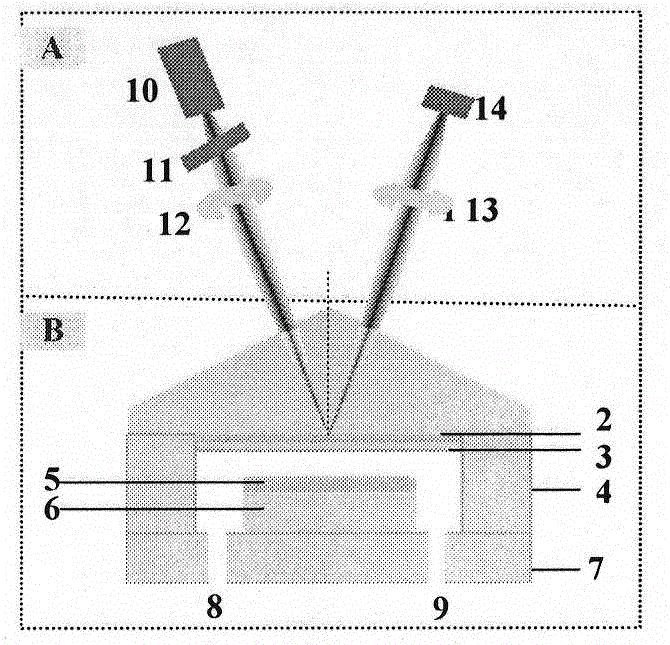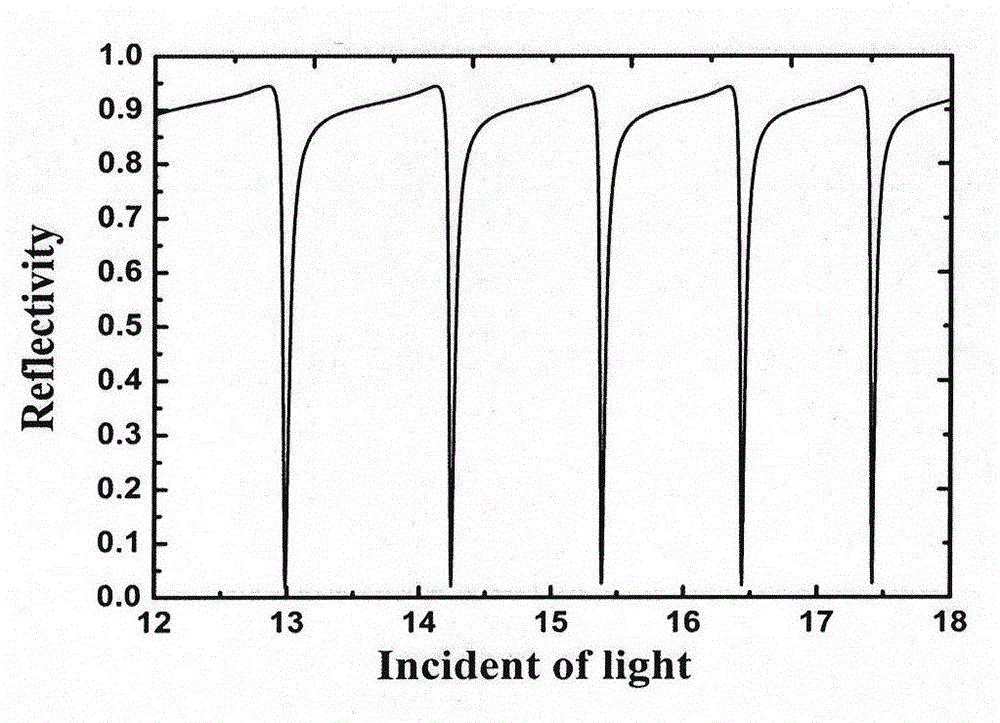Refractive index measurement method with wide range
A refractive index and large-range technology, applied in the field of precision analysis and measuring instruments, can solve problems such as unfavorable real-time, online applications, limited measurement accuracy, unfavorable accurate measurement, etc.
- Summary
- Abstract
- Description
- Claims
- Application Information
AI Technical Summary
Problems solved by technology
Method used
Image
Examples
Embodiment 1
[0015] Assuming that the wavelength of the incident laser light λ = 650nm, the refractive index n of the glass prism 1 =1.80, the dielectric coefficient ε of the upper metal film 2 =-14.0+i1.3, thickness h 2 =45nm, the refractive index n of the silicon dioxide protective layer 3 =1.50, thickness h 3 =60nm, the dielectric coefficient ε of the lower metal film 5 =ε 2 =-14.0+i1.3, thickness h 5 =200nm (these parameters are accurately measured during the preparation process), the thickness of the glass island 6 is less than the glass gasket 4, the difference between the two h analyte = h 4 -h 6 =20 μm (the exact value can be determined by measurement and simulation calculation). Assuming that the sample cavity is filled with a gas with a low refractive index (nm = 15 °, the laser beam is a TM wave after passing through the polarizer 11, and the angular width Δθ=18 °-12 °=6 ° after being converged by the lens 13, then 5 black lines will appear in the reflected beam (refract...
Embodiment 2
[0021] Assuming that the sample cavity is filled with an aqueous solution of a material (n>1.33), and other parameters remain unchanged, it is found that 4 black lines appear in the reflected beam, indicating that there are 4 angles in this angular width that satisfy the matching of the guided mode Conditions, by measuring the position of the black line on the CCD, four matching angles are obtained: θ m+1 =12.582°, θ m =14.328°, θ m-1 =15.881°, θ m-2 = 17.288°. Using the reflectivity formula to simulate and calculate the following parameters:
[0022] (1) The module sequence number m=80, therefore, the module sequence numbers of the four modules excited are 78, 79, 80 and 81 respectively;
[0023] (2) The thickness of the sample cavity is h analyte = 19.570 μm;
[0024] (3) The refractive index of the sample is n analyte = 1.40890.
[0025] The reflectivity curve simulated by computer is as image 3 Shown:
Embodiment 3
[0027]Assuming that what is filled into the sample cavity is a polymer colloid solution with a high refractive index (greater than that of the prism), and other parameters remain unchanged, it is found that 3 black lines appear in the reflected beam, indicating that there are 3 black lines in this angular width. The three angles meet the matching conditions of the guided mode. By measuring the position of the black line on the CCD, three matching angles are obtained: θ m+1 =12.647°, θ m =15.091°, θ m-1 = 17.202°. Using the reflectivity formula to simulate and calculate the following parameters:
[0028] (1) The modulus number m=117, therefore, the modulus numbers of the three modes excited are 116, 117 and 118 respectively;
[0029] (2) The thickness of the sample cavity is h analyte = 19.590 μm;
[0030] (3) The refractive index of the sample is n analyte = 1.98746.
[0031] The reflectivity curve simulated by computer is as Figure 4 Shown:
PUM
| Property | Measurement | Unit |
|---|---|---|
| Top angle | aaaaa | aaaaa |
| Thickness | aaaaa | aaaaa |
| Thickness | aaaaa | aaaaa |
Abstract
Description
Claims
Application Information
 Login to View More
Login to View More - R&D
- Intellectual Property
- Life Sciences
- Materials
- Tech Scout
- Unparalleled Data Quality
- Higher Quality Content
- 60% Fewer Hallucinations
Browse by: Latest US Patents, China's latest patents, Technical Efficacy Thesaurus, Application Domain, Technology Topic, Popular Technical Reports.
© 2025 PatSnap. All rights reserved.Legal|Privacy policy|Modern Slavery Act Transparency Statement|Sitemap|About US| Contact US: help@patsnap.com



